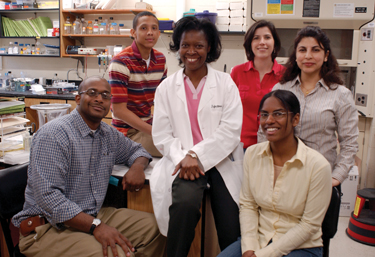
Wonder Drake, M.D., center, and her research team, from left, James Carlisle, M.D., Shamaal Miller, a second-year medical student, Shannon Allen, Ph.D., Rana Hajizadeh, research assistant, and Whitney Evans, research intern.
Photo by Dana Johnson
Studies seek clues to curb inflammatory disease’s march
There were 5,000 patient visits to Vanderbilt University Medical Center clinics last year related to sarcoidosis, an inflammatory disease that can attack any organ of the body in any location.
Now a Vanderbilt physician is spearheading two studies of the disease that affects people younger than 50 to find out more about its cause and treatment.
The disorder is characterized by granulomas — small collections of inflamed cells — which can be either inside or on an exterior surface of the body, appearing as plaque on the face or legs. Most often — about 90 percent of the time — it is found in the lungs, and in those cases, 20 percent to 30 percent of patients are left with permanent lung damage.
Symptoms range from cough, shortness of breath and mild chest pain in patients with pulmonary sarcoidosis to a scaly rash, fever, pain and swelling on those who have the disorder on the outside of the body. Patients can also suffer from fatigue, weight loss and fever.
Sarcoidosis prefers people 20-50, affects both sexes, and is found four times more often in African-Americans than Caucasians.
“The disease also has a worldwide prevalence, highest in Norway and Sweden and second highest in the southeastern United States, but we don't know why it prefers those areas,” said Wonder Drake, M.D., assistant professor of Medicine.
A 1994 graduate of Vanderbilt University School of Medicine, Drake has studied sarcoidosis for the past six years, first for a research project as a fellow. Recently, she received an award for her research from the Foundation on Sarcoidosis at the 2006 American Thoracic Society meeting.
“Sarcoidosis is considered a rare disease — affecting 30 to 50 people per 100,000, but it's one of the more common rare diseases,” she said. “And it's frequently misdiagnosed. There's no test to definitively make the diagnosis. It's a diagnosis of exclusion,” Drake said. “Studies show that, on average, it takes six to nine months from the time symptoms present to get a diagnosis,” she said.
The cause of the disorder is not known, although it is thought by most scientists to be a disorder of the immune system, where the body's natural defense system malfunctions.
One of the Vanderbilt studies involves assessing for the presence of microbial nucleic acids in tissue samples from patients with sarcoidosis, investigating for the presence of mycobacteria, similar to that in tuberculosis.
“When sarcoidosis was first described by Jonathan Hutchinson in 1869, he said he thought it was an infection, but nobody has been able to prove that infectious agents are important,” Drake said.
In fact, sarcoidosis was at first thought to be an odd form of TB, but when researchers stain the tissue of patients looking for TB, the tests are negative and when sarcoidosis patients are given drugs that are active against TB, they don't improve.
“Our molecular work suggests that an organism genetically similar to, yet distinct from, Mycobacterium tuberculosis, is present within the sarcoidosis granulomas. It's something genetically close to TB, but not TB,” Drake said.
The study is part of a national collaboration among Vanderbilt, National Jewish Medical and Research Center, University of Colorado Health Sciences Center and the University of Colorado at Boulder, looking at patients with sarcoidosis of the lungs, eye and skin.
The second study is more translational, determining the way the immune systems of patients respond.
“With new technology, we can probe for mycobacterial nucleic acids in sarcoid tissue, then translate the nucleic acids to amino acids. We can take immune cells from sarcoidosis subjects to see if the cells recognize these bacterial antigens,” Drake said.
The study looks at how the immune system responds in those who get better and in those who go on to have a more chronic, debilitating form of the disease.
“We think their immune systems are responding to these antigens differently,” Drake said. She hopes to enroll 1,600 patients in the study — 800 with sarcoidosis and 800 healthy participants. Some patients with TB will also be included.
Patients are currently given prednisone to help suppress the immune system.
But the drug, particularly in women, causes side effects such as weight gain, depression and the development of osteoporosis.
“We are learning that the current staining and culture methods used to identify infectious agents do not allow us to identify all pathogens. The purpose of these two studies is to use rigorous molecular and immunologic assays to determine if infectious agents have a role in sarcoidosis pathogenesis. If infectious agents are really important to this disease, suppressing the immune system may not be the ideal treatment,” Drake said.
“If we can cure patients with sarcoidosis, they are less likely to have advanced lung disease, less likely to die.”
One of Drake's patients is a 27-year-old father of two, blind from sarcoidosis in his brain. “Patients like this really motivate me to work hard to do what I can to make life better for these people,” she said.













